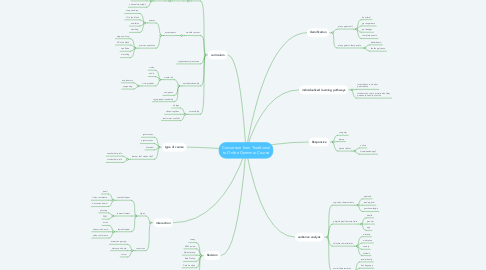
1. interaction
1.1. types
1.1.1. teacher/learner
1.1.1.1. email
1.1.1.2. video conference
1.1.1.3. discussion board
1.1.2. learner/content
1.1.2.1. glossary
1.1.2.2. FAQ
1.1.3. learner/learner
1.1.3.1. email
1.1.3.2. discussion board
1.1.3.3. video conference
1.2. resources
1.2.1. interactive gaming
1.2.2. discussion board
1.2.3. forum
2. type of course
2.1. synchronous
2.2. asynchronous
2.3. blended
2.4. teacher led/ student led?
2.4.1. teacher help info
2.4.2. student help info
3. curriculum
3.1. syllabus
3.1.1. objectives
3.1.1.1. standards
3.1.1.1.1. PERT requirements
3.1.1.1.2. state standards
3.1.1.1.3. national standards
3.2. module content
3.2.1. assessments
3.2.1.1. quizzes
3.2.1.1.1. drag and drop
3.2.1.1.2. fill in the blank
3.2.1.1.3. true/false
3.2.1.1.4. matching
3.2.1.2. practice questions
3.2.1.2.1. drag and drop
3.2.1.2.2. fill in the blank
3.2.1.2.3. true/false
3.2.1.2.4. matching
3.3. supplementary resources
3.4. aesthetics/usability
3.4.1. media rich
3.4.1.1. video
3.4.1.2. audio
3.4.1.3. vivid graphics
3.4.1.3.1. explanatory
3.4.1.3.2. supporting
3.4.2. navigation
3.4.3. typography/readability
3.5. accessibility
3.5.1. alt tags
3.5.2. closed captions
3.5.3. text format availabl
4. Revision
4.1. survey
4.2. SEM review
4.3. Alpha testing
4.4. Beta Testing
4.5. Data Analysis
4.6. Revision
5. individualized learning pathways
5.1. level adapts to student performance
5.2. students choose to practice what they personally need to practice
6. Responsive
6.1. computer
6.2. laptop
6.3. phone /tablet
6.3.1. online
6.3.2. downloaded app?
7. Gamification
7.1. play against self
7.1.1. beat level
7.1.2. get experience
7.1.3. get badges
7.1.4. complete quests
7.2. play against other people
7.2.1. leaderboard
7.2.2. challenge friends
8. audience analysis
8.1. cognitive characteristics
8.1.1. aptitude
8.1.2. reading level
8.1.3. prior knowledge
8.2. physiological characteristics
8.2.1. health
8.2.2. gender
8.2.3. age
8.3. affective characteristics
8.3.1. interests
8.3.2. motivation
8.3.3. anxiety
8.3.4. attitude
8.4. social characteristics
8.4.1. race/ethnicity
8.4.2. first language
8.4.3. relation to peers
8.4.4. feelings toward authority

